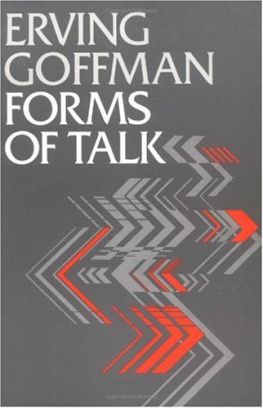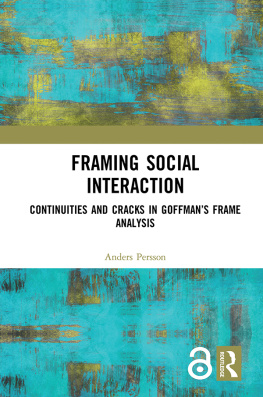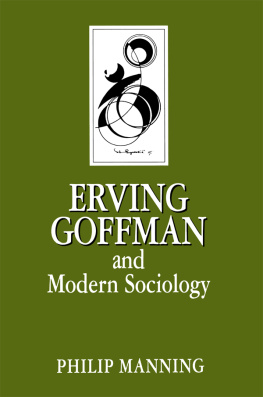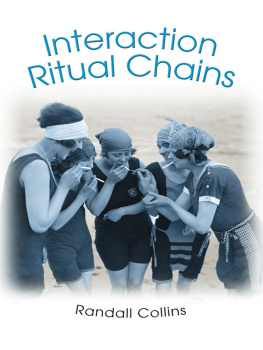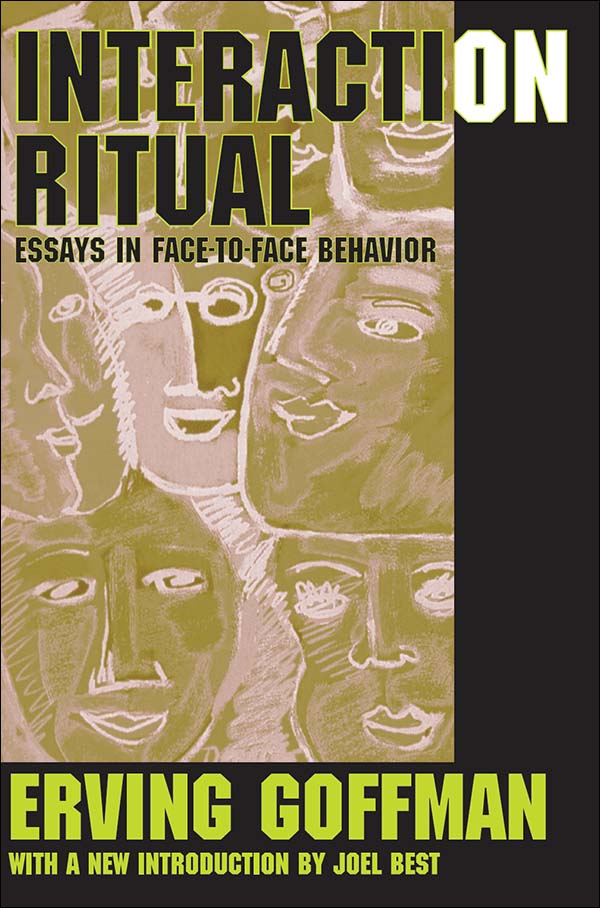Contents
INTERACTION RITUAL
INTERACTION RITUAL
ESSAYS IN FACE-TO-FACE BEHAVIOR
ERVING GOFFMAN
WITH A NEW INTRODUCTION BY JOEL BEST

First published 1967 by Transaction Publishers
Published 2017 by Routledge
2 Park Square, Milton Park, Abingdon, Oxon 0X14 4RN
711 Third Avenue, New York, NY 10017, USA
Routledge is an imprint of the Taylor & Francis Group, an informa business
New material this edition copyright 2005 by Taylor & Francis.
Copyright 1967 by Erving Goffman.
All rights reserved. No part of this book may be reprinted or reproduced or utilised in any form or by any electronic, mechanical, or other means, now known or hereafter invented, including photocopying and recording, or in any information storage or retrieval system, without permission in writing from the publishers.
Notice:
Product or corporate names may be trademarks or registered trademarks, and are used only for identification and explanation without intent to infringe.
Library of Congress Catalog Number: 2005048515
Library of Congress Cataloging-in-Publication Data
Goffman. Erving.
Interaction ritual: essays in face-to-face behavior / Erving Goffman ; with a new introduction by Joel Best.
p.cm.
Originally published; Chicago; Aldine Pub. Co., c 1967. With new introd.
Includes bibliographical references.
Contents; On face-workThe nature of deference and demeanor
Embarrassment and social organizationAlienation from interaction
Mental symptoms and public orderWhere the action is.
ISBN 0-202-30777-8 (pbk. : alk. paper)
1. Social interaction. 1. Title.
HM111.G64 2005
302dc22
2005048515
ISBN 13: 978-0-202-30777-0 (pbk)
CONTENTS
On Face-Work: An Analysis of Ritual Elements in Social Interaction is reprinted with permission from Psychiatry: Journal for the Study of Interpersonal Processes, Volume 18, Number 3, August 1955, PP- 213-31. Copyright 1955 by the William Alanson White Psychiatric Foundation, Inc.
Embarrassment and Social Organization is reprinted with permission from The American Journal of Sociology, Volume 62, Number 3, November 1956, pp. 264-74.
The Nature of Deference and Demeanor is reprinted with permission from American Anthropologist, Volume 58, June 1956, pp. 473-502. Copyright 1956 by the American Anthropological Association. All rights reserved.
Alienation from Interaction is reprinted with permission from Human Relations, Volume 10, Number 1, 1957, pp. 47-59.
Mental Symptoms and Public Order is reprinted with permission of the Walter Reed Army Institute or Research.
Where the Action Is was prepared with the assistance of a grant from the Youth Development Program of the Ford Foun-ation and the Center for the Study of Law and Society, University of California, Berkeley, under a grant from the Office of Juvenile Delinquency and Youth Development, Welfare Administration, U. S. Department of Health, Education and Welfare in cooperation with the Presidents Committee on Juvenile Delinquency and Youth Crime. Support was also re-ceived from the Institute of Human Development, University of California, Berkeley, and from the Center For International Affairs, Harvard University. Edwin Lemert has provided detailed criticisms for which I am very grateful. Comments on Nevada casino gambling are based on a study in progress.
The first four papers were published while I was a member of the Laboratory of Socio-environmental Studies, National Institute of Mental Health, and I am grateful for the Laboratorys support. For support in bringing this collection of six papers together for publication, I am grateful to the Center For International Affairs, Harvard University.
Interaction Ritual was a pivotal work in the illustrious career of Erving Goffman. Between 1959 and 1963, Goffman published five books that vaulted him from near obscurity into the front ranks of American sociology. Three of these have endured as classic works in the field: The Presentation of Self in Everyday Life (1959), Asylums (1961), and Stigma (1963).
The enthusiasm for Goffmans early books reflected the growing disenchantment with the dominant, nor-mal-science strains of postwar sociology, particularly the grand theories of Talcott Parsons on the one hand, and the growing fascination with the quantitative analysis via survey research and experimentation on the other. This sociological establishment had come under fire from such prominent critics as G. Wright Mills in The Sociological Imagination (1959) and Pitirim Sorokin in Fads and Foibles in Modern Sociology (1956). Sociologists were searching for alternative approaches.
And Goffman certainly offered an alternative. His subject matter was unique. In sharp contrast to the natural tendency of many scholars to tackle big, important topics (and thereby produce what would presumably be acclaimed as big, important works), Goffman was a minimalist, working on a small scale, and concentrating on the most mundane, ordinary social contacts, on everyday life. His methods were equally peculiar. While Goffman had done some ethnographic researchfirst on a Scottish island, and later in a large mental hospitalhe had surprisingly little interest in systematically describing these scenes. His goal was to spot elementary processes that underpinned all social life. To be sure, hed occasionally use an example taken from his field work, but he was much more likely to draw upon a broad range of written sourcesstudies by sociologists, anthropologists, and other social scientists, but also autobiographies, novels, and newspaper stories.
As a result, his work was difficult to classify. Although his early work often centered on aspects of the self, it didnt fall into any of the familiar genres of social psychology, not the survey researchers efforts to understand attitudes, nor the experimentalists studies of small groups, nor the symbolic interactionists abstract theorizing. Rather, Goffman saw the self as embedded in particular situations. Fbr Goffman, the self was primarily motivated by a desire to be well regardedboth by others and by oneselfand every interaction offered occasions for eliciting that regard.
Goffmans work can be seen as offering a series of alternative takes or perspectives on these processes, each centered around a different concept. Most famously, of course, The Presentation of Self in Everyday Life offered a dramaturgical perspective, an argument that interaction could be seen as performances before audiences. But other works concentrated on other facets of interaction: the two essays in Encounters (1961) portrayed interaction in terms of first games, and then roles; Behavior in Public Places (1963) highlighted the importance of involvement; just as Strategic Interaction (1969) focused on strategy, and Frame Analysis (1974) on frames. Much of his later work, such as Relations in Public (1971), or the papers found in Forms of Talk (1981), tended to concentrate on conversational sequences.
There was a playfulness to this exploration of alternative perspectives. Goffmans point was not that interaction was either a drama or a game or a frame, but rather that each of these concepts offered a potentially useful standpoint or angle from which one might viewand come to understand something aboutsocial life. The response of other sociologists to these different orientations varied: the ideas of dramaturgy, stigma, and frame continue to attract many adherents; others, such as role distance, found early favor but seem to have fallen from memory; and still others, such as involvement and strategic interaction, never really caught on.


